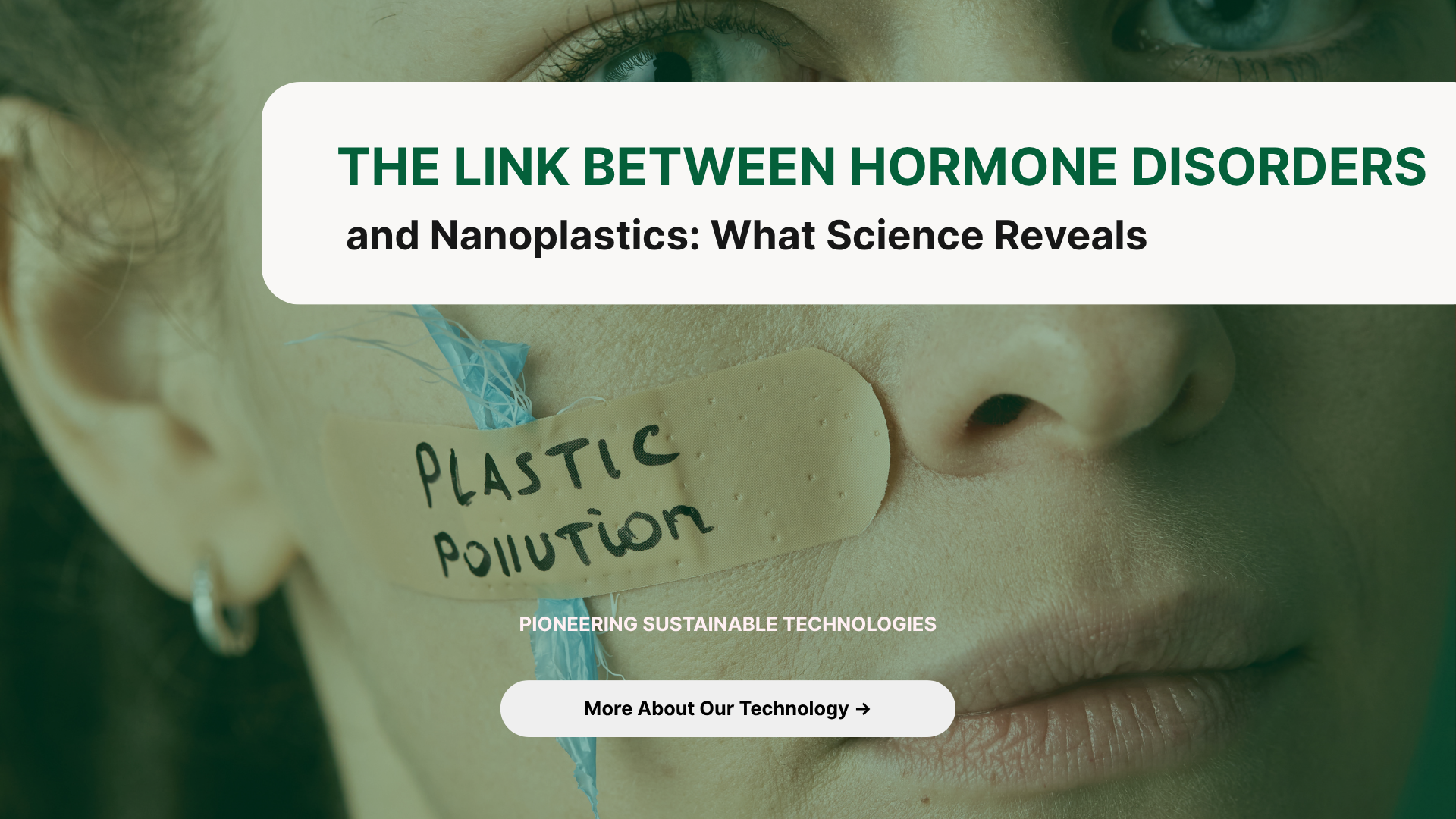As research on microplastics continues to evolve, one dimension has emerged as particularly concerning: the biological impact of nanoplastics on the human endocrine system. These plastic fragments, smaller than 1 micrometre, are now being detected in blood, brain tissue, placenta and vital organs, and their presence appears to correlate with rising rates of hormone-related disorders.
While traditional environmental health debates have focused on industrial pollutants or pharmaceuticals, scientists are now uncovering compelling links between plastic exposure and endocrine disruption. The implications are profound, especially for fertility, child development, and long-term metabolic health.
This article explores what nanoplastics are, how they interact with hormone systems, and why switching to biodegradable, non-toxic packaging like Eco Bottle may be more than a sustainability decision. It could be a critical health one.
What Are Nanoplastics and How Do They Get Into the Body
Nanoplastics are plastic particles less than 1000 nanometres in size, thousands of times thinner than a human hair. Unlike microplastics, which can be trapped in the gut or lungs, nanoplastics are small enough to cross biological barriers such as:
• The blood–brain barrier
• Placental membranes
• Intestinal walls
• Cellular membranes
Recent studies have found these particles in breast milk, human placentas, testicular tissue, and blood plasma, raising concern that nanoplastics are not just environmental pollutants. They are systemic.
Main exposure routes include:
• Drinking bottled water containing over 240,000 plastic particles per litre
• Eating seafood or processed food packaged in plastic
• Breathing household dust and airborne particles
• Using personal care products with plastic-derived compounds
Once inside the body, nanoplastics may behave like endocrine-disrupting chemicals, mimicking or interfering with natural hormone signals.
How Nanoplastics Disrupt the Endocrine System
The endocrine system governs everything from metabolism and growth to reproductive health and mood. It is delicately balanced, with hormones like estrogen, testosterone, insulin, thyroid hormones and cortisol working in precise feedback loops.
Unfortunately, nanoplastics, particularly those made from polyethylene, polystyrene and polyvinyl chloride, often carry or leach phthalates, bisphenol A and styrene oligomers.
These are known endocrine disruptors.
Once in the bloodstream, nanoplastics may:
• Bind to hormone receptors and disrupt normal function
• Interfere with hormone synthesis and secretion
• Alter gene expression in hormone-responsive tissues
• Cause inflammation in hormone-producing glands
In animal studies, exposure to nanoplastics has been linked to:
• Decreased sperm quality and testosterone levels
• Disrupted ovarian function and menstrual cycles
• Early onset of puberty in females
• Impaired thyroid function
• Insulin resistance and increased fat accumulation
These effects mirror trends seen in human health data, where fertility rates, metabolic disorders and thyroid dysfunction are rising alongside plastic exposure.
Hormonal Disorders on the Rise, Coincidence or Correlation
Over the past three decades, the global population has seen a measurable rise in the following hormone-linked conditions:
• Male infertility: A 2023 meta-analysis revealed a 50 percent decline in sperm count since 1973
• Thyroid disease: Australia’s rates of hypothyroidism and autoimmune thyroiditis continue to climb, particularly in women
• Early puberty: Onset of puberty in girls has accelerated globally, linked to endocrine disruptors and increased body mass
• Polycystic ovary syndrome: Now affects approximately one in ten women of reproductive age
• Endometriosis and hormone-sensitive cancers: Higher incidence rates seen in regions with heavy plastic and chemical exposure
While multiple factors influence hormone health, including diet, stress and genetics, mounting research implicates synthetic chemical exposure, including nanoplastics, as a modifiable risk factor.
What the Latest Science Tells Us
In March 2024, a landmark study published in the New England Journal of Medicine revealed microplastics embedded in the arteries of over 50 percent of surgical patients. The same study reported a 4.5 times higher risk of heart attack and stroke in those individuals.
Meanwhile, Columbia University researchers used Raman spectroscopy to confirm nanoplastics in commercially available bottled water, detecting up to 240,000 particles per litre. The vast majority were small enough to enter the bloodstream and organs.
A 2023 animal study from the National Institute of Environmental Health Sciences showed that nanoplastics:
• Reduced testosterone and disrupted testicular function in mice
• Triggered autoimmune responses in the thyroid gland
• Caused estrogenic activity in breast tissue
• Altered neurohormone signalling in the hypothalamus
The implications are clear and alarming.
Why Plastic-Free Water Bottles Matter for Hormone Health
Given the ubiquity of plastic exposure, avoiding it entirely may seem impossible. But meaningful reduction is achievable through smart consumer choices.
Eco Bottle, Australia’s only 100 percent biodegradable and microplastic-free bottled water, represents a tangible step toward minimising daily plastic intake.
How it protects hormone health:
• Made with a non-toxic organic additive that breaks down fully in landfill
• Leaves no microplastics behind, confirmed through decomposition studies
• Releases zero endocrine-disrupting chemicals during use or degradation
• Uses natural spring water, free from phthalate contamination
This is not just about environmental impact. Reducing your exposure to hormone-disrupting plastics may help safeguard reproductive health, metabolic function and long-term disease risk.
The Bigger Picture, Health Policy and Plastic Reform
Despite mounting evidence, nanoplastics remain largely unregulated in global health frameworks. Most food safety standards have yet to establish threshold limits or testing requirements for plastic particles below one micron in size.
Public awareness, scientific pressure and consumer demand will be crucial in driving:
• Policy change at federal and international levels
• Product reform from beverage and packaging companies
• Independent testing of bottled water, baby formula and food containers
• Funding for further longitudinal studies into hormonal impact
The more consumers understand about the endocrine effects of plastic, the greater the urgency for change.
Key Summary
✓ Nanoplastics are now found in blood, placenta, breast milk and organs
✓ They disrupt hormone function by mimicking or blocking endocrine signals
✓ Disorders like infertility, thyroid disease and early puberty are rising in parallel
✓ Bottled water may contain over 240,000 nanoplastic particles per litre
✓ Eco Bottle is 100 percent biodegradable, microplastic-free and hormone-safe
✓ Avoiding plastic exposure is a critical health move, not just an environmental one
✓ More research and stronger regulation are urgently needed to protect public health
References
NEW ENGLAND JOURNAL OF MEDICINE. Microplastics in Human Arteries and Cardiovascular Risk. Mar. 2024. Available at: https://www.nejm.org
COLUMBIA UNIVERSITY. Nanoplastics in Bottled Water: Spectroscopy-Based Quantification. Feb. 2024.
NATIONAL INSTITUTE OF ENVIRONMENTAL HEALTH SCIENCES. Nanoplastics and Hormonal Function in Murine Models. 2023.
WHO. Endocrine Disruptors and Human Health: Global Assessment. 2021.
CLEAN UP AUSTRALIA. Plastic Pollution and the Human Body. 2024. Available at: https://www.cleanup.org.au
AUSTRALIAN BUREAU OF STATISTICS. Trends in Fertility and Hormone-Linked Conditions in Australia. 2023.
THE GREENER TECH GROUP. Eco Bottle Technology Brief. 2025. Internal document.

